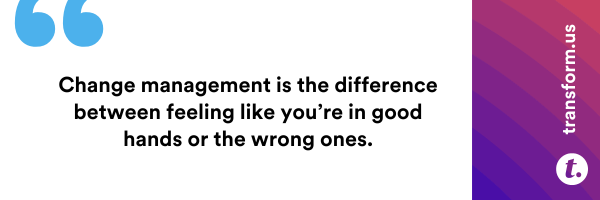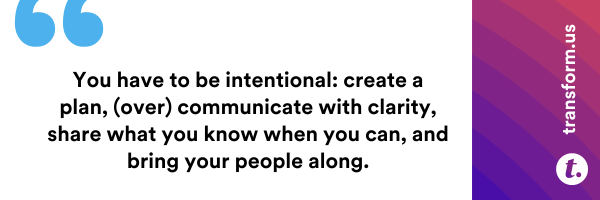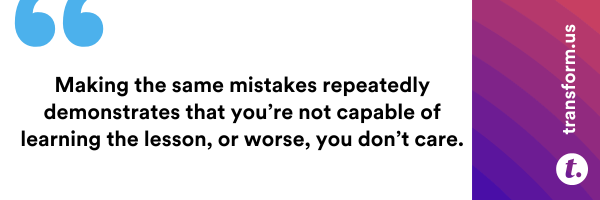
Change management is not a new concept—as long as businesses have existed, they’ve been changing—changing for their consumers, the economy, new opportunities, their employees, and the list goes on.
However, what is surprising about change management is that it is rarely a point of focus or mastery, even though change is inevitable and necessary no matter where you work. Just like “culture eats strategy,” how you manage change is a culture driver, too.
As an employee, change management is the difference between feeling like you’re in good hands or the wrong ones. Think about it – the best experiences many of us have had with change are informed by the concept of fair process and with people we trust to guide us through uncertainty. Change mishandled can lead to a lack of trust in the company, the leadership, and the managers. Worst, underestimating an organization’s capacity for change, managing change badly, or pushing too many changes to happen at once can hurt your customer experience and your bottom line. If you don’t trust the captain to manage both calm and challenging waters, you usually want to get off the ship ASAP.

With this in mind, here are a handful of principles that have helped me and may help you, too:
A Certain Kind of Change
Some changes are small, and others are big enough to warrant a plan. You usually know the difference based on the impact assessment. How does this change impact revenue, customers, employees, systems, and/or the company’s reputation? If the span is wide and high enough for one or more of these factors, you’ve got a substantive change, and you’ll need an intentional plan to guide it to the finish line. Intention means assessing the change itself, the dependencies, timing, and what’s within and outside your control – and then leveraging all that to bring the right people together and draft a structured plan.
Applying Fair Process
Fair process is the concept that people will trust the outcome if they trust the process. Your goal is not to satisfy everyone’s preferences or meet their definition of fair but to share as much about the why, the what, and the how as you can within reason. It means having a plan and not just winging it. Sometimes you can preview change and sometimes not – in both cases, don’t underestimate the importance of explaining the why and meeting people where they are, as best you can with the information. Bringing people along means a commitment to showing up and transparency, even when your answers aren’t what your audience wants to hear.

Repetition and Clarity
During an internal fireside chat at HubSpot, a board member, Jill Ward, encouraged communicating with “cartoon clarity” to ensure a message lands the way it should. When you think about cartoons or animation on TV today, whether you know the show or what’s going on, the lines are distinct, the colors vibrant and sharp. Applying this principle to communication means using clear, simple language, sticking to the facts, and leveling with folks. You also have to be prepared to repeat yourself. Nothing ruins a plan for change worse than a bad game of telephone, so remember it’s usually not one and done on an email or that town hall – embrace repetition across multiple channels to land the message.
Managers First
Your managers are your front line so that the questions will come to them first. Invest in keeping them above board by ensuring they have the context, talking points, and resources ahead of the change (or in the early days of it). While expected to have all the answers, we know managers have questions too, so offering them an exclusive space to share what’s top of mind for them and to be vulnerable before they face their teams is also a gesture that wouldn’t go unnoticed.
Power Pause
Change usually happens, and we move on. We move on from the pandemic, the product launch, the reorganization, the layoff, the merger, etc., but we don’t stop to reflect on what (within our control) went right and wrong in those processes. Reflection ensures we capture the lessons and develop a playbook for managing change that aligns with the organization’s culture and values. It is also an important step to mitigate the presence of past mistakes when change happens again in the future. Mistakes happen, and as much as we strive to limit them, if they’re going to happen, you want to make new mistakes, not old ones. Making the same mistakes repeatedly demonstrates that you’re incapable of learning the lesson, or worse, you don’t care.

The last thing I’d add here is that change in a small company versus a large one can feel different. You have to work harder to get a change cascaded down to thousands of people in a matrixed organization versus dozens, BUT the principles above apply whether you have a staff of 10 versus 10,000. You have to be intentional: create a plan, (over) communicate with clarity, share what you know when you can, and bring your people along. These steps ensure you play both the short and long game to win on change.
See Sam’s insights on Change Management and more when she speaks at Transform 2025 taking place on March 17 – 19 at Wynn Las Vegas. If you haven’t already bought your ticket, secure your place now!

Guest Author: Samantha Simmons, Senior Vice President of People & Culture at Spurs Sports & Entertainment
Author Bio: Sam currently serves as the Senior Vice President of People & Culture at Spurs Sports & Entertainment (SS&E), which owns and operates the San Antonio Spurs, Austin Spurs, and San Antonio Futbol Club. Sam has forged her career in guiding organizations and leaders in fulfilling their potential, developing and implementing holistic strategy, building high-performing, inclusive teams, and driving sustainable organizational change at scale. Her experience spans various industries, but the common thread remains people. Before SS&E, she worked at HubSpot, Wayfair, and Koya Partners, as well as in the nonprofit and education space.
